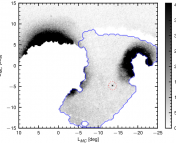Title: Evidence of ram pressure stripping of WLM, a dwarf galaxy far away from any large host galaxy
Authors: Yanbin Yang, Roger Ianjamasimanana, Francois Hammer, Clare Higgs, Brenda Namumba, Claude Carignan, Gyula I. G. Józsa, Alan W. McConnachie
First Author’s Institution: Observatoire de Paris, PSL, CNRS, France
Status: Accepted as a letter by Astronomy & Astrophysics, available on arXiv
A Galaxy Far Far Away… (From Other Galaxies)
The Universe is a pretty big place, but sometimes we find surprising things by looking at our (nearish) neighbors. Way out on the edge of our galaxy’s neighborhood, the Local Group, there sits a dwarf galaxy named Wolf–Lundmark–Melotte (WLM). Now, there are quite a few dwarf galaxies in the Local Group, but one reason WLM is special is because it’s so remote, which means it likely hasn’t interacted with other galaxies in a while.
There are also two strange things about its rotation. First, WLM’s rotation curve indicates that its mass is dominated by dark matter – the dark matter of WLM is more massive than its regular old baryonic matter by a factor of 90! This is a dramatic difference compared to the Milky Way, where dark matter outweighs baryonic matter by a factor of ~20. What’s more, its rotation is asymmetric; the sides of WLM that approach and recede away from us are moving at different velocities. This asymmetric rotation leads today’s authors to believe that something must be perturbing the motion of WLM.
Looking for Clues from Gas at the Outskirts
Using observations from the MeerKAT radio telescope, the authors looked at neutral hydrogen (HI) on the outskirts of WLM. They found a group of HI clouds northwest of WLM which contain a substantial portion (~10%) of the gas content of the galaxy. The authors propose two explanations for the presence of these gas clouds. Although WLM is relatively isolated nowadays, perhaps long ago WLM merged with another object, and these gas clouds are from the end stages of this merging process. However, if this were the case, we would expect to see stars distributed both in the main body of WLM and the nearby gas clouds. Because the stars of WLM aren’t distributed in the gas clouds, the authors think another explanation is more likely: ram pressure stripping.
Imagine that you’re holding a dandelion while running. As the dandelion moves through the air, some of its seeds will float off. This is because the velocity of the dandelion as it moves through the air creates a drag force in the direction opposite to its motion. If this force is stronger than the force that binds the dandelion seeds to the dandelion, they’ll get stripped away. This phenomenon, known as ram pressure stripping – can occur in galaxies too. As a galaxy moves through the intergalactic medium (the diffuse gas that exists between galaxies), if the ram pressure force exceeds the gravitational force that holds the gas of a galaxy together, some of the galaxy’s gas can get blown away like the seeds of a dandelion.
In Figure 1, WLM’s direction of motion is shown with a green arrow. The position of the HI clouds is in the opposite direction from the motion of the main body of WLM, which suggests that ram pressure stripping could have separated this gas from the main body of WLM. This hypothesis is strengthened by simulations of HI column density maps for WLM under the assumption that ram pressure stripping occurs, which match the structure of HI seen from observations.
How Could Ram Pressure Stripping Happen to WLM?
Ram pressure stripping is more likely to occur in a dense environment – for example, in a satellite dwarf galaxy near the edge of a larger galaxy. WLM’s isolated location in the Local Group, far from larger galaxies like the Milky Way and M31, makes the evidence for ram pressure stripping surprising.
To determine a lower estimate for the density necessary to strip the HI clouds from WLM, the authors use an analytic threshold for ram pressure stripping, which balances the pressure exerted by the intergalactic medium on a moving galaxy with the gravitational force that holds the galaxy together. Through this analysis, they find that WLM is moving through an unexpectedly high density medium, which suggests that either the medium around WLM may be particularly clumpy, or there is an unforeseen reservoir of mass distributed throughout the Local Group. Either way, it seems that the relatively empty region of the Local Group where WLM resides is less vacant than previously thought.
Edited by Catherine Manea
Featured Image Credit: NOIRLab/NSF/AURA/CTIO/Local Group Survey Team and T.A. Rector (University of Alaska Anchorage), Herbert Goetsch




